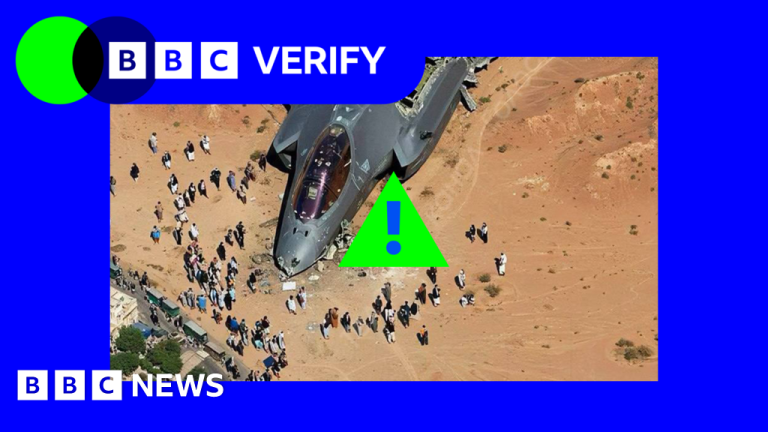Disinformation Campaign Explodes Online Amidst Israel-Iran Conflict
The recent exchange of strikes between Israel and Iran has ignited a firestorm of disinformation online, with artificially generated videos and misleading content dominating social media platforms. BBC Verify’s investigation has uncovered a concerted effort to manipulate public perception, amplifying both sides of the conflict through fabricated visuals and recycled footage. The sheer volume of disinformation, described as "astonishing" by open-source imagery analysts, marks a new era of conflict manipulation in the digital age. The proliferation of AI-generated content, in particular, raises concerns about the increasingly blurred lines between reality and fabrication in online narratives.
Pro-Iranian accounts have flooded platforms with AI-generated videos boasting of Tehran’s military might, while simultaneously disseminating fake clips purporting to show successful attacks on Israeli targets. Some of the most viral videos have garnered over 100 million views, reaching a vast audience and potentially shaping public opinion on a global scale. Conversely, pro-Israeli accounts have engaged in their own disinformation campaign, primarily by recirculating outdated footage of protests in Iran, falsely portraying them as evidence of growing dissent against the government and support for Israel’s actions. This tactic aims to undermine the Iranian government’s image and create a narrative of internal instability.
The rise of obscure pro-Iranian accounts with seemingly official names but no clear ties to Tehran has further muddied the waters. These accounts, often adorned with verification checkmarks, have gained significant traction in a short period, spreading disinformation to a rapidly expanding follower base. The ambiguity surrounding their origin and purpose raises questions about the actors behind the campaign and their motivations. This rapid growth underscores the ease with which disinformation can spread through social media, particularly during times of conflict.
The use of generative AI in this conflict marks a significant escalation in online disinformation tactics. AI-generated images and videos, often depicting nighttime attacks which are difficult to verify, add another layer of complexity to the challenge of discerning fact from fiction. One particularly striking example is an AI-generated image depicting a missile attack on Tel Aviv, viewed over 27 million times. The prevalence of such fabricated content underscores the urgent need for sophisticated verification tools and heightened media literacy.
A prominent theme within the pro-Iranian disinformation campaign has been the alleged destruction of Israeli F-35 fighter jets. Numerous AI-generated videos and images claim to show these advanced aircraft being shot down, creating a narrative of Iranian military superiority. However, these claims remain unsubstantiated, with no verified footage of such incidents emerging. Experts suggest that this focus on the F-35, a symbol of American military technology, may be driven by networks linked to Russian influence operations, aiming to undermine confidence in Western weaponry.
The proliferation of disinformation during this conflict is not limited to obscure accounts. Well-known accounts with a history of commenting on the Israeli-Palestinian conflict and other geopolitical events have also contributed to the spread of misleading information. While motivations vary, some experts suspect that financial incentives tied to views and engagement on social media platforms may be driving this behavior. This dynamic highlights the potential for conflict to be exploited for personal gain in the online sphere.
Pro-Israeli disinformation has taken a different tack, focusing on portraying the Iranian government as facing increasing internal opposition. A notable example is an AI-generated video falsely depicting Iranians chanting "we love Israel" on the streets of Tehran. More recently, with speculation growing about potential US strikes on Iranian nuclear facilities, some accounts have begun sharing AI-generated images of B-2 bombers over Tehran, the only aircraft capable of effectively targeting Iran’s underground nuclear sites. These images further contribute to the tense atmosphere surrounding the conflict.
Alarmingly, even official sources in both Iran and Israel have shared some of the fake images and videos, lending them an undeserved air of credibility. This underscores the pervasive nature of disinformation and the difficulty in identifying credible sources even for official bodies during times of conflict. The involvement of state media in spreading fake news highlights the strategic use of disinformation as a tool of propaganda.
The sheer volume of fake videos and images shared on platforms like X (formerly Twitter) has overwhelmed users’ ability to discern fact from fiction. Even X’s AI chatbot, Grok, has been misled by the sophisticated AI-generated content, repeatedly asserting the authenticity of fake videos and citing reputable news outlets, further complicating the verification process for users. The spread of disinformation on other platforms like TikTok and Instagram further amplifies the reach of these narratives.
The pervasiveness of this disinformation campaign underscores the urgent need for improved media literacy and more effective content moderation by social media platforms. The speed and scale at which disinformation can spread online necessitate a proactive approach to identifying and removing fake content, as well as empowering users to critically evaluate the information they encounter. The escalating use of AI in generating disinformation presents a significant challenge to these efforts.
The psychological underpinnings of disinformation sharing contribute to the rapid dissemination of misleading content online. Individuals are more likely to share information that aligns with their pre-existing beliefs and political identities, particularly during times of conflict when emotions run high. This inherent bias makes sensationalized and emotionally charged content, often associated with conflict narratives, more prone to viral spread, regardless of its veracity.


